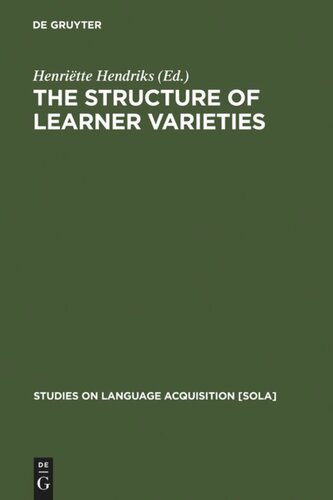

Most ebook files are in PDF format, so you can easily read them using various software such as Foxit Reader or directly on the Google Chrome browser.
Some ebook files are released by publishers in other formats such as .awz, .mobi, .epub, .fb2, etc. You may need to install specific software to read these formats on mobile/PC, such as Calibre.
Please read the tutorial at this link: https://ebookbell.com/faq
We offer FREE conversion to the popular formats you request; however, this may take some time. Therefore, right after payment, please email us, and we will try to provide the service as quickly as possible.
For some exceptional file formats or broken links (if any), please refrain from opening any disputes. Instead, email us first, and we will try to assist within a maximum of 6 hours.
EbookBell Team

4.8
44 reviewsThis volume brings together ten contributions to the study of untutored (mainly) second but also first language acquisition. All chapters have been written from a functionalist perspective and take as the main theoretical framework a model of spontaneous second language acquisition centered on the "basic variety" as proposed by Klein and Perdue. The chapters in the volume are grouped around two research themes. The first theme concerns the acquisition of scope phenomena (negation, scope particles), the second one deals with referential movement (reference to person, time and space). Both parts provide insights in the structure of learner varieties at various stages of development, and are followed by a discussion chapter.
Scope phenomena, such as negation and frequency adverbials present an important learning problem, as learners have to reconcile the logical structure of their utterances with the syntactic specifics of the language being learned. Their acquisition has been relatively neglected in studies up to date, however, and we even lack detailed knowledge about the interpretation of scope particles in the target languages. The chapters in this part of the volume set out to provide more knowledge about scope phenomena in general; more detailed descriptions of the particles in the languages under consideration; and a more general understanding of how scope is acquired. Strong findings resulting from the "ESF" project suggested universal trends in how untutored learners deal with acquisition in the very early stages (the basic variety). Chapters in this second part of the volume on referential movement look at acquisition at more advanced stages, including the production of near native speakers. Learners who progress beyond the basic variety increasingly grammaticalise their productions. This later development is supposedly more variable, as more specific aspects of the target languages are now being acquired. Chapters in this part allow to shed more light on the question regarding universal and language-specific influences on language acquisition.